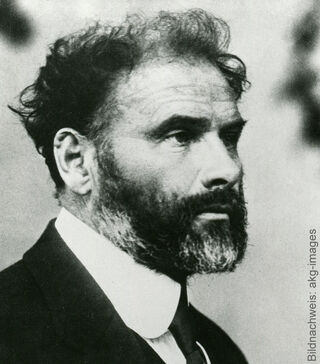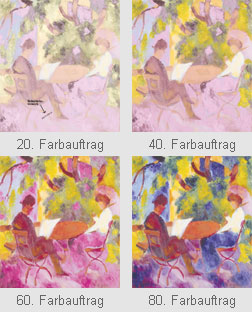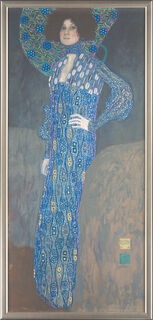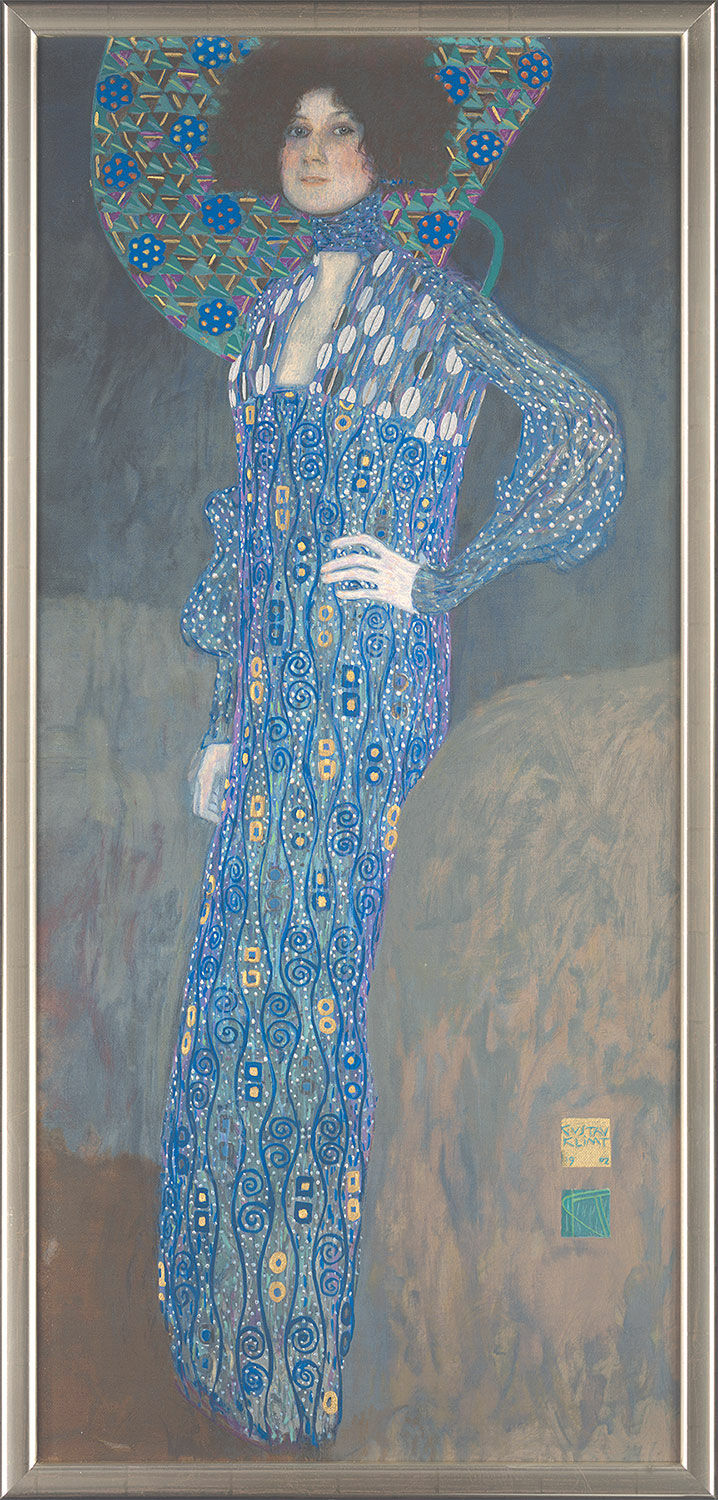Picture "Portrait of Emilie Flöge" (1902), framed


Picture "Portrait of Emilie Flöge" (1902), framed
Quick info
limited, 950 copies | original Dietz replica | oil on canvas | on stretcher frame | framed | size approx. 114.5 x 54.5 cm (h/w)
Detailed description
Picture "Portrait of Emilie Flöge" (1902), framed
The designer, couturier and entrepreneur Emilie Louise Flöge was a fascinating personality of the Fin de Siècle and Gustav Klimt's partner. Klimt portrayed this icon of Art Nouveau in a self-designed dress that was considered revolutionary women's fashion.
Klimt frequently painted Emilie Flöge. In 1903, for the very first time, the picture was exposed to the public. However, she did not identify with this picture because it resembled a beautiful, bored lady of Viennese society rather than the businesswoman with her own career - who she really was.
Original: 1902, oil on canvas, Kunsthistorisches Museum, Vienna.
Original Dietz replica. Oil on canvas in 90 colours with real gold and real silver finishing. Limited edition of 950 copies. Each canvas replica is stretched on stretcher frames like the original, so you can re-stretch the canvas as room temperature and humidity fluctuate. Framed with a silver real wood strip. Size incl. frame approx. 114.5 x 54.5 cm (h/w).
Customer reviews
Ein wunderschönes Bild und ein Blickfang für jeden Raum - sagenhaft!

About Gustav Klimt
1862-1918, Austrian painter, a famous representative of Viennese Art Nouveau
Gustav Klimt (1862-1918) was already a renowned artist, influencing the Art Nouveau style of Vienna's famous Ringstrasse with his murals and co-founding the Vienna Secession, when he created his "Golden Style". Inspired by the Byzantine mosaics, he inserted ornamental colour surfaces into a golden bed just like encased gemstones. With his visual art, Klimt describes the path of life of human beings who, negatively influenced by instincts, find their redemption in the kiss. The depictions of the body convey a subtle eroticism, although their figures dissolve into ornamental and geometric colour surfaces. He utilized this method not only for his depictions of couples but also for his portraits of rich women and landscape paintings. This two-dimensional style is today the epitome of Klimt's intensely coloured art, which, however, only characterises his work from 1905 onwards.
Klimt was not only adept at gold and opulence but was also a brilliant draughtsman. He produced numerous drawings in the course of his life. Mostly as preliminary studies for larger works.
As a son of an engraver, Klimt learned his craft at Vienna‘s School of Applied Arts. While still seeking to find his own artistic style, his early work is based on historicism especially influenced by Hans Makart, the artist Prince of the Habsburg monarchy in the late 19th century. Together with his brother Ernst and Franz Matsch, the three young painters formed an artistic community and received numerous commissions to design new buildings on Vienna's Ringstrasse. The staircases of Vienna's Burgtheater or the Museum of Fine Arts bear witness to the historicist style of this collaborative team.
In the late 1890s, like so many young and open-minded artists of the fin de siècle, Gustav Klimt abandoned the academic tradition. In 1897, together with other artists, he founded the "Wiener Secession", which he presided over as president until his resignation in 1905. To this day, the Secession's exhibition building remains a place and temple for new young art.
Günter Dietz developed a revolutionary method for the authentic reproduction of paintings, where not the usual printing inks are used, but the same original colours used by the artist. Depending on the artist's painting technique, up to 140 (!), different paint applications need to be applied in order to achieve a perfect replica of the original that also tangibly reproduces the "relief" and pastosity of colour composition.
Here are the examples of 'Couple at the Garden Table' by August Macke:

Furthermore, the same material as the original, such as reproduction on canvas, paper, wood, copper, parchment is always used.
The result is a perfect, gridless reproduction that comes very close to the original in expressiveness and effect. Even museum specialists often can not distinguish the replica from the original. Therefore, a special security note must be added, which is visible only under X-rays.
The edition of most Dietz replicas is limited, usually to 950 copies. Each canvas replica is stretched onto a frame as the original, so you can retighten the canvas in case of fluctuations in room temperature and humidity. A high-quality solid wood strips round off every Dietz replica.
Numerous masterpiece paintings of Rembrandt, Caspar David Friedrich, Claude Monet, Gustav Klimt and various others have been recreated by the "Dietz Offizin". Famous modern artists such as Pablo Picasso, Salvador Dalí, Max Ernst, Friedensreich Hundertwasser, Joan Miró and Marc Chagall have used this method developed by Günter Dietz in order to have replicas of their works produced.
Press comments:
"The Dietz System provides images as good as the originals. What the electronics did with the invention of Hi-Fi and stereo for music playback - here the graphic technology made up for visual art." (Die Zeit, German newspaper)
"In theory, there is no difference between the original and the Dietz replica. They should not be called reproductions, but facsimiles." (Newsweek, US-American news magazine)
"For art printers all over the world remains unrealizable to this day, what Dietz only managed with the help of printing technology: The perfect reproduction of painted works." (Der Spiegel, German news magazine)
Art Nouveau, or the German term Jugendstil (lit.: "Youth Style"), is the art epoch between 1890-1910. The name originates from the Munich-based magazine "Jugend" (Youth), founded in 1896. It was the German counterpart of Art Nouveau (France), but also internationally known as Modern Style (England) or Secession (Austria).
Art Nouveau conquered all of Europe and innumerable works were created, ranging from painting and applied arts to architecture. One of the requirements of Art Nouveau was the artistic design of everyday objects, i.e. beauty and practicality were combined. The desired unity of the artistic ability could only be achieved through individually influenced design, which made the Jugenstil the precursor of modernism. The essential characteristic of Art Nouveau is linear, often asymmetrical ornamentation. The models are particularly taken from nature and flora.
Major Art Nouveau centres were formed in Munich, Darmstadt, Brussels, Paris and Nancy (Glass Art by Emile Gallé). The Viennese architecture of that time was determined by Otto Wagner and J. Hoffmann. Gustav Klimt created paintings that gave sensual shape to the spirit of Art Nouveau.
A true-to-the-original reproduction of an artwork in the same size and with the best possible material and colour uniformity.
The mould is usually taken directly from the original so that the replication reproduces even the finest details. After casting the replication, using the most appropriate method, the surface is polished, patinated, gilded or painted according to the original.
A replication of ars mundi is a recognizable copy of the original.


